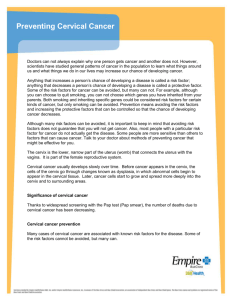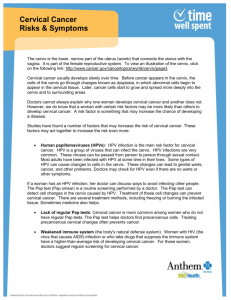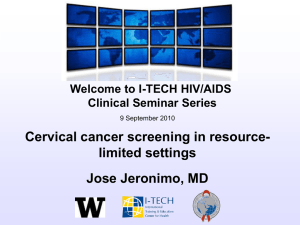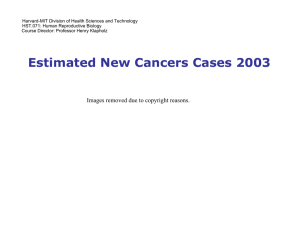HDI Quality Insider Voume 1, Number 4 – Cervical Cancer Screening
advertisement
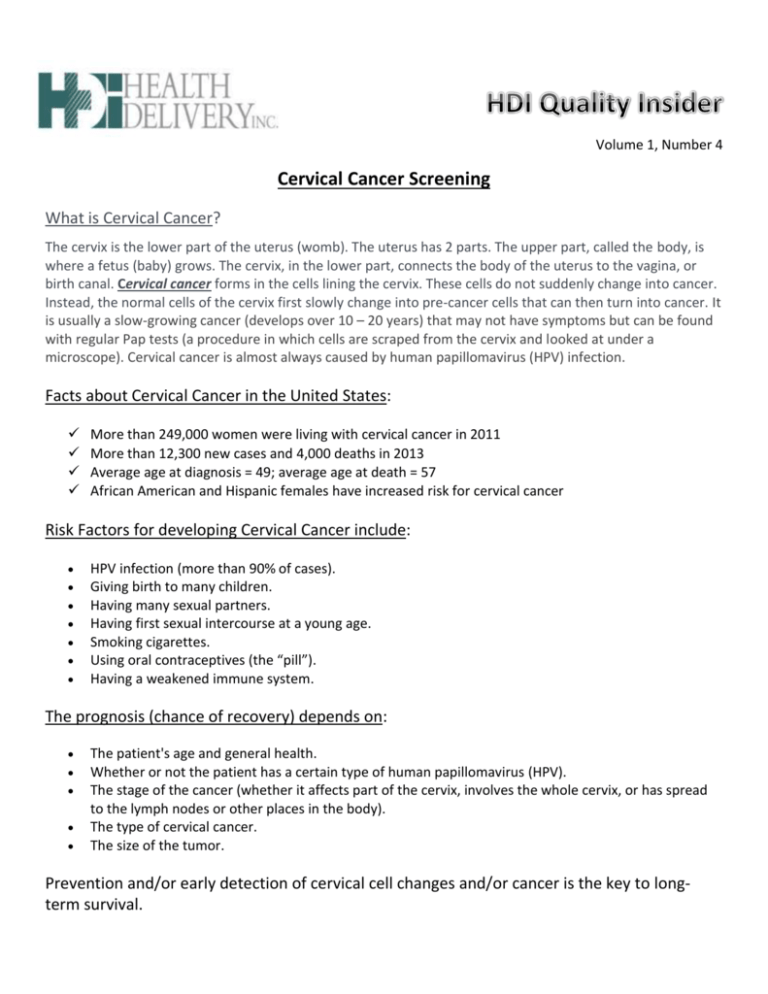
Volume 1, Number 4 Cervical Cancer Screening What is Cervical Cancer? The cervix is the lower part of the uterus (womb). The uterus has 2 parts. The upper part, called the body, is where a fetus (baby) grows. The cervix, in the lower part, connects the body of the uterus to the vagina, or birth canal. Cervical cancer forms in the cells lining the cervix. These cells do not suddenly change into cancer. Instead, the normal cells of the cervix first slowly change into pre-cancer cells that can then turn into cancer. It is usually a slow-growing cancer (develops over 10 – 20 years) that may not have symptoms but can be found with regular Pap tests (a procedure in which cells are scraped from the cervix and looked at under a microscope). Cervical cancer is almost always caused by human papillomavirus (HPV) infection. Facts about Cervical Cancer in the United States: More than 249,000 women were living with cervical cancer in 2011 More than 12,300 new cases and 4,000 deaths in 2013 Average age at diagnosis = 49; average age at death = 57 African American and Hispanic females have increased risk for cervical cancer Risk Factors for developing Cervical Cancer include: HPV infection (more than 90% of cases). Giving birth to many children. Having many sexual partners. Having first sexual intercourse at a young age. Smoking cigarettes. Using oral contraceptives (the “pill”). Having a weakened immune system. The prognosis (chance of recovery) depends on: The patient's age and general health. Whether or not the patient has a certain type of human papillomavirus (HPV). The stage of the cancer (whether it affects part of the cervix, involves the whole cervix, or has spread to the lymph nodes or other places in the body). The type of cervical cancer. The size of the tumor. Prevention and/or early detection of cervical cell changes and/or cancer is the key to longterm survival. Prevention options include: 3 dose series of HPV vaccines (females and males age 11 – 26) Abstinence from sexual activity Always use a condom Cervical cancer screening with pap smears and HPV testing guidelines: All women should begin cervical cancer testing (screening) when they are 21. Women aged 21 to 29 should have a Pap test every 3 years. Women age 30 to 65 should be screened with a Pap test combined with an HPV test every 5 years. Another choice for women 30 to 65 is to get tested every 3 years with just the Pap test. Women who are at high risk of cervical cancer (for instance, because of a weak immune system from HIV infection, organ transplant, long-term steroid use, or because they were exposed to DES when their mothers were pregnant with them) may need to be screened more often. They should follow the recommendations of their healthcare team. Women over 65 years of age who have had regular screening (with Pap tests with or without HPV tests) in the past 10 years should stop cervical cancer screening as long as they haven’t had any serious pre-cancers found in the last 20 years. Women who have had certain pre-cancers should keep on being tested for at least 20 years after the pre-cancer was found. Women who have had a hysterectomy (where both the uterus and cervix were removed) should stop screening (such as Pap tests and HPV tests) unless the surgery was done as a treatment for cervical cancer or pre-cancer. Women who have had a hysterectomy that left behind the cervix should continue to follow the guidelines above. Women who have been vaccinated against HPV should still follow these guidelines. HDI monitors and reports Cervical Cancer Screening rates annually; results for 2012 – 2014 show continued improvement in rates: 2012 = 34% 2013 = 60% As of July 31, 2014 = 63% Call to Action: Females (age 21 +): Follow guidelines above to screen for cervical cancer. Males and Females (age 11 -26): Complete 3 dose series of HPV vaccines - protects you and future sexual partners. HDI is committed to providing “Quality Healthcare for Everyone.” Look for more information about our quality projects and PCMH in future editions of the HDI Quality Insider. If you have questions, please talk to any member of our staff.





